Ski boots

Choosing the right ski boots is a guarantee that you will learn how to ski correctly faster and will have fun not only when you take them off. Our article will help you get answers to your questions.






Peculiarities
The ski boot is a plastic construction that connects to the ski mount, locks in place securely, and thus holds the skier's feet in place, protecting them from injury and helping to move. Ski boots are heavy and tough, and are made up of two parts: a plastic boot and an inner padded boot. On the outside, there are clips with buckles that fix the structure on the leg.

This is a very specific shoe that over time will adapt not only to the anatomical features of your feet, but also to your physical fitness and skiing technique.
It is much easier to get used to different skis than to a different pair of boots. Therefore, experts advise not to ride for a long time in rented or someone else's shoes.




Views
Womens
Most manufacturers produce unisex models, but it is better to give preference to women, which are designed from a softer material, taking into account the characteristics of the female figure and leg structure. When the legs are in a bent state, in women, the center of gravity is shifted more backward, which is important. Also, calves are often bulkier than men's calves, so the cuff height should be lower.




Large sizes
Today, almost any company can find models in large sizes. For women - from size 41, for men - from size 46. Large manufacturers even provide the ability to customize boots for a specific type of skiing.


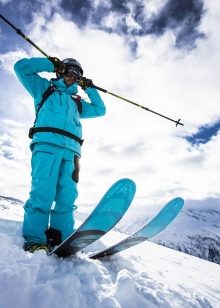
Models
Universal
They can be cross-country or ski.
- Cross-country skiing is suitable for speed skating and classic riding and for any type of skiing: tourist, pleasure or professional. These are high boots with a moderately stiff sole and a removable cuff.
- Alpine skiing is used for skiing on pistes or off pistes - in deep snow. In them, you can adjust the inclination of the boot, taking into account the style and conditions of the ride. They must be carefully sized.

Designed for skiers who ride in a classic style - it does not involve heavy loads on the ankle. They are walking, tourist and sports. These are low shoes that do not impede the movement of the foot. They have a soft sole and no cuffs, so you can walk without skis. The only nuance that needs to be taken into account is that they are not suitable for skating.

Cross-country
Designed for fast movement over long distances in snowy areas. Therefore, it is important that they protect the foot from moisture and cold and ensure safe riding. This is a two-layer model that is not afraid of low temperatures.
Ankle support system is used in professional boots. In walking models, the emphasis is on dryness and comfort.

For alpine skiing
They are radically different from the previous model, they consist of an outer and an inner boot. In terms of rigidity, they are divided into three types: for beginners, for experts and for professionals. The stiffer the boot, the more accurate and faster the transfer will be to the skis, and the more your weight, the harder they should be.





They should not be used for cross-country skiing, nor are they suitable for long walks.

For skating
This type of skiing gets its name from the fact that the movements of the skier resemble those of the skater. You need to push off with two legs, usually this is done to accelerate.


These are stiff boots that should cover the ankle and prevent injury. They are selected individually, taking into account the peculiarities of the structure of the foot. They should not dangle on the leg, provide a secure fixation of the foot and provide an effective push.

For skiathlon
Suitable for mixed cross-country skiing, classic and skating. This is a rather difficult technique, because during the race, a constant change of skis is necessary. In this case, the mount on the boots must be universal in order to fit both skis styles.

They have a stiff sole and reliable ankle support that lasts even when the cuffs are unbuttoned. Most often, such shoes are bought only by professional athletes, they are useless for an ordinary amateur.

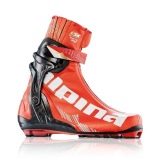


Velcro
They are exclusively for children, there can be a maximum of 35-36 sizes. If the size is larger, zippers or laces are used as fasteners. As a rule, they are bought for children 5-10 years old, who cannot cope with lacing themselves. Designed for cross-country skiing only.





Brands: manufacturers overview
Armada
One of the leading manufacturers, it was created by a group of professional skiers. The brand's boots are completely thought out, therefore they are as functional as possible. Each model has its own unique features that delight skiers with their appearance.

Salomon
The brand that once developed the meil carres ski bindings system. The company has a lot of open-source accounts that were of great importance for the world of skiers. The brand's winter sports boots have conquered the market almost since their inception.
During production, new technologies are constantly being introduced that really work.




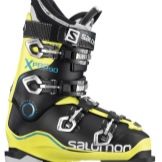


Full tilt
The legendary brand behind the ribbed tongue 3-clip ski boot. The unique design was developed through the use of unique space technologies. Subsequently, they became the prototype for modern plastic ski models.
The brand has always been distinguished by high European quality, and their shoes today can boast of a combination of convenience, practicality and unique design.






Rossignol
A French brand specializing in the production of high-tech clothing, footwear and winter sports equipment. The company has come a long way from the production of wooden skis to the introduction of innovative technologies.
The company has won awards more than once, but it constantly continues to improve for people who are in love with skiing.


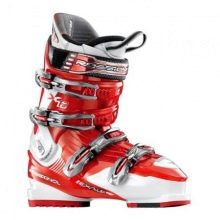
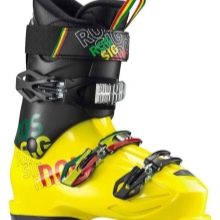


Burton
The brand is known even to novice skiers. Its founder became the progenitor of snowboarding as an extreme sport and opened the world's first snowboard manufacturing facility. Produces equipment, clothing and footwear for skiers and surfers, its products remain the standard of the highest quality.

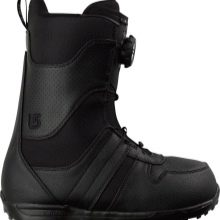




Accessories
Most skiers purchase special heated socks and insoles to keep their feet warm. They are powered by a compact battery that does not interfere with active movement. They are compatible with most boot models, and thanks to the heating, they fit perfectly to the shape of the foot.


A special bag or backpack for boots will not be superfluous, in which they can be transported from place to place. It will not let the shoes freeze, which is very important, because in the cold the plastic becomes hard, and it will be extremely problematic to put on such a boot.


How to choose?
Before buying, it is important to know exactly your foot length, training level, riding style and determine for yourself how much you expect.
- Rigidity. The most important selection criterion. The most tough ones are designed for professionals. They have a fairly high bootleg and 4 clips. Such boots are the least comfortable, but they help to carry out an accurate transfer to the skis, which is important when driving fast.
For beginners, soft boots with two clips are suitable, the rigidity of which can be adjusted using laces or belts. They have a tongue for easy putting on and taking off.
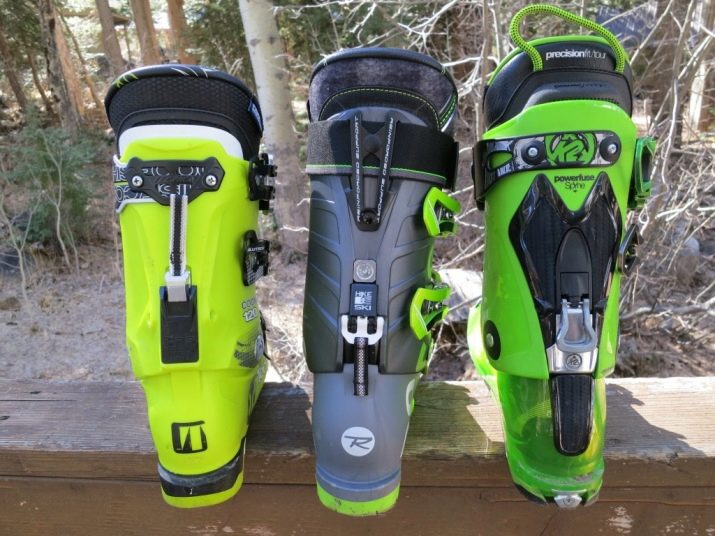
- The size. It is identified by an inner boot that fits snugly around the leg. The wider models are intended for amateurs, the narrower ones are suitable for professionals.
It is best to buy shoes in a specialty store, where the seller will measure the length and width of the foot on bent knees - so the foot is a little longer. The boot should fit snugly along the entire length of the leg.

- The weight. Professional boots are heavier and should be taken into account as the weight of the shoe will affect the climb.
- Sole length. It is indicated separately, since it does not match the size. It is necessary in order to properly adjust the ski mounts.
- Fastening. Must match exactly with the ski mount. It is best if they come from the same manufacturer.
- Regulators. They allow you to adjust the footwear to the volume of your feet. Minimum quantity on kids 'boots and beginners' models.
There are such regulators: clips, straps, a stiffness switch, a walk-roll function that makes it easier to move, an inner boot that takes the shape of your leg.

How to put on and store correctly?
To put on your ski boots, first try to keep them warm. Transport them in a tight bag or warm them up somewhere. It is best to put on special thermal socks under your boots, which not only warm, but also prevent the occurrence of lumps and folds.

- Unbutton the boot from top to bottom, spread the flaps of the bootleg, and pull the tongue out and out to the side. Insert your foot into the boot, making light rotational movements. It should be "screwed" into the shoes, as it were.
- Push the tongue and collars back into place.To help your heel settle in, lightly tap your foot on the ground.
- Fasten the clips from the bottom up. You need to fix the leg well, but not very tightly. After a few descents, the boots will warm up, and you will be able to "hold out" the clip, if necessary. It is especially convenient to do this if it is threaded.
You will be able to visually see and repeat how to put on and take off ski boots if you watch the video.
Storing boots is much easier. They have the shape of the letter G, so it is convenient to fold them "facing" each other, like Tetris. They have a slight slope, so it is difficult to press them tightly, but still, they will take up less space. To secure them to each other, fasten them with the straps or Velcro, which are provided on each shoe.


The box in which they are sold is rather bulky, so there is no point in storing boots in it. They are plastic and tough, so they will not deform or lose their shape. To keep them from gathering dust, cover them with a cover or put them in a bag. They take up a minimum of space when they stand vertically on the rack. But if it is more convenient for you, you can put them on - this does not affect the shoes in any way.
Important! Before storing, the boots should be thoroughly dried to avoid the appearance of untidy odors and mildew.



Fashion trends
Ski boots are constantly "evolving", so it is important to take into account modern trends and new technologies. If you are going to buy a new pair, let it be in line with the latest trends.

Rase and parasporting amateurs
Such boots remain rather conservative, manufacturers use an established production scheme. Only the variable flex and the inner boot are improved, which they try to bring to the ideal. One of such new products is the Raptor B2 RD model from the Head brand.

Ski for lovers
Manufacturers are constantly trying to improve shoes from this segment, make them more comfortable, personalize according to individual volume, and at the same time make them lighter, but maintain sufficient rigidity for movement accuracy. Comfort depends on the inner part of the shoe, the most advanced technologies today are used by the Sidas and Intuition brands.
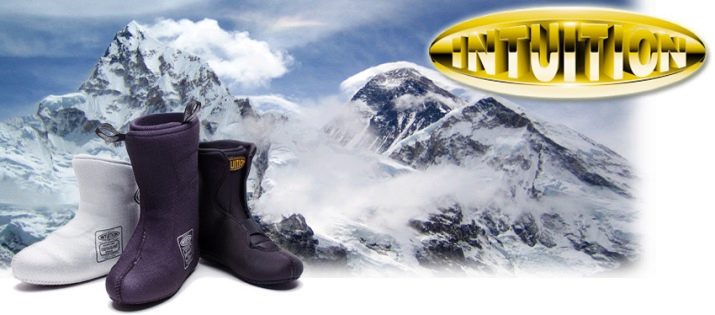
The best personalization (the ability of the shoe to adapt to the anatomical features of your foot) comes from the Atomic and Fisher brands. The lightest amateur boots are offered by the brands Atomic and Salomon.



In general, good brands manage to bring their plans to life, but such boots are very expensive, and cheap ones do not stand up to criticism. It is definitely not worth saving, so you will have to spend a lot on high-quality shoes.

Ski models for ski tour and freeride
In either case, the most important thing is the weight of the boots, since 1 kg on your feet is the same as 5 in a backpack. To lighten models from this segment, manufacturers use carbon. It allows you to maintain rigidity, but to reduce the thickness of the boot, for example, as in the SCOTT Cosmos boots.

The real innovator in this area is the Fischer brand with the Travers Carbon. Not only did it use carbon, the brand also ditched locks in favor of lacing! Also, the outer boot became thermoformed, which made it possible to obtain the ideal model.

Reviews
Even without being professionals, most skiers say it's better to get their own boots rather than rent them. This is especially important for those who have had injuries and fractures of the legs. Many people note the quality of Salomon and Atomic, which are suitable for beginners, are at reasonable prices, but at the same time provide a reliable fixation of the leg.



The Head brand is popular with lovers of comfort - you can ride in boots of this brand and enjoy a hot drink in a coffee shop.

If you have a narrow foot, it is advised to pay attention to the Lange brand boots. They are quite rigid and at the same time fix the leg well.




Most note that the main thing is not the company, but the right model.In the boots you choose, you should feel comfortable so that the shoes do not press or rub and it is convenient for you to ride.

Useful Tips
Seasoned skiers provide some important tips:
- You shouldn't use used boots, even if someone gives them to you for free. Modern models adapt to the anatomical features of the foot, and the new owner will be uncomfortable in them.
- Even if you are a beginner, it is not worth buying soft "beginner" boots. In a year or two, they will have to be changed to stricter ones, but they are not cheap.
- Buy a model with 4 clips, with micro-adjustment and straps for putting on.
- Do not buy boots with a stiffness lower than 90, they are not suitable for long-term use.
- It's worth buying shoes that are tailored to your gender. For example, women have a wider foot and a higher rise, the manufacturer takes this into account in production.
- If you have any peculiarities of the foot, it is better to purchase a special orthopedic insole, for example, they can be found from the Sidas brand. They're not cheap, but worth it for leg problems.









